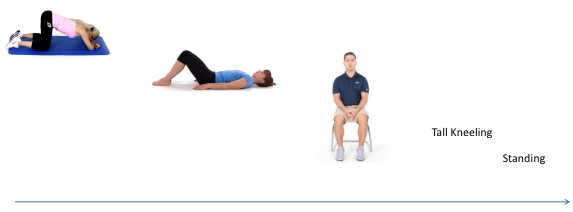exercise programming for injury prevention 3/24
1/13
There's no tags or description
Looks like no tags are added yet.
Name | Mastery | Learn | Test | Matching | Spaced |
|---|
No study sessions yet.
14 Terms
kegel
for urinary incontinence
several factors can contribute to weak pelvic floor muscles, including pregnancy, birth, surgical procedures, aging, excessive straining due to constipation or chronic coughing, being overweight
involves isometric contractions of pelvic floor muscles
part of rx program for incontinence
follows same strength training principles as other muscles—isom is a key rx and progression is primarily via gravitational force
kegel progression
elbows & knees quadruped/assisted bridge→hooklying or sidelying→sitting→tall kneeling→standing

kegel instructions and prescription for HEP
make sure bladder is empty, then assume appropriate starting position
tighten pelvic floor muscles, hold 3-5 seconds and progress to 6-10 seconds after 2-3 weeks
imagine sitting on a marble and tighten pelvic muscles as if trying to lift marble, hold 3 seconds, relax for 3
for optimal results→contract solely pelvic flor muscles, don’t engage abs, thighs, buttocks; don’t hold breath
dosage: 10 reps, 3x daily; follow up 2-3 days after initial consult then every 2 weeks
ACL rehab framework
immediate postoperative period (week 0-3))
early rehabilitation (weeks 1-6)
intermediate rehabilitation (weeks 6-12)
advanced rehabilitation (months 3-6 and beyond)
immediate postoperative period (week 0-3)
pain management, swelling reduction
isometrics and concentric to preserve mm and joint physiology
early rehabilitation (weeks 1-6)
controlled, supervised exercises to gradually restore knee ROM
initial strengthening exercises for quads and hamstrings
WB activities as tolerated
intermediate rehabilitation (weeks 6-12)
advanced strengthening exercises for entire LE
proprioceptive and balance training to improve joint stability
introduce low-impact CV exsc
initiate more functional activities
advanced rehabilitation (months 3-6 and beyond)
continued progression of strength and endurance training
integration of sport-specific exsc
gradual return to more intense challenging activities
monitor for signs of readiness for gradual return to activity/sports
key exercises to consider for ACL rehab
quad sets, ankle pumps, SLRs
triple leg extension exercises w/o impact
small/moderate amplitude, low impact symmetrical jumps
box jump up-phase
stationary cycling, swimming→running
depth jump
countermovement squat jumps sticks
repetitive CMJs+symmetrical jumps
huddle CMJs—forward, lat: sticks→non sticks
huddle CMJs—rotational: sticks→non sticks
power, NM control and perturbation exsc: frog jumps w elastic band, swiss ball perturb (touch/toss) with CMJs: sticks→ non sticks
performance based and return to “work” activities: simulated work type movements, intensive S&C
fall prevention rehab
standing sway exsc fwd/back, left/right
fixed-support rehab strategy
LBP prevention/management
flexibility/mobility exsc—cat-cow, prayer, SKTC, LTR, makenzie exsc
strength training exsc—bird dog, superman (alternate→simultaneous), dead bug
both important for prevention, but flexibility during acute flare up is helpful
makenzie exsc
progress from prone on elbows to back ext from prone as tolerated
neuromuscular training warm-up exercises
structured exsc that train nerves and muscles to react and communicate efficiently w each other and w brain
help address neuromuscular deficits that puts athletes at risk of injury during sports participation
exercises target improvements in movement quality and control during change of direction and landing activities, improvements in core strength and stability, improvements in local muscle strength and joint stability
reduces risk of diverse musculoskeletal injuries by 40-67% and improved athletic performance
components of neuromuscular training warm-up program
“integrated” aerobic exsc, strength exsc, balance exsc, agility exsc
cardio and tissue activation, movement control/quality exsc, focused strength training, dynamic stretches, sport-specific movements